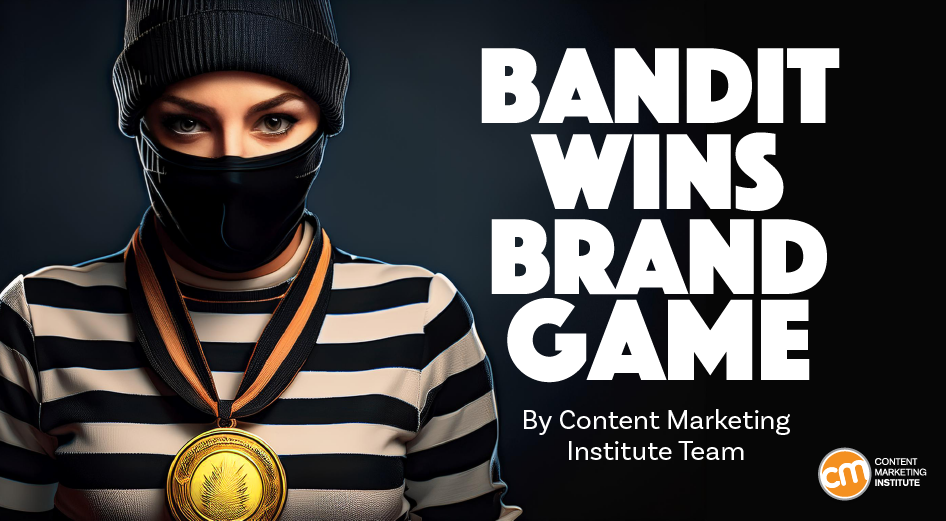
Marketing plasters the Olympics.
In the Parade of Athletes, at every event venue, and during every media opportunity, the competitors generally wear the branded apparel of their country’s sponsor. Unless, of course, the athlete is a star who has a different brand deal.
For example, Nike is the apparel brand sponsor for the U.S. delegation, but men’s basketball star Steph Curry has a deal with Under Armour. So, Steph doesn’t wear a Nike-branded uniform on the court.
Olympic athlete sponsorship is a competitive sport unto itself, and it involves big, big money.
But what about all the unsponsored athletes who earned a spot and could become the next Simone Biles, Trinity Rodman, or Katie Ledecky?
One small sports apparel brand came up with a brilliant solution that also brought it worldwide awareness.
We turned to CMI’s chief strategy advisor, Robert Rose, to tell the story and its takeaway for marketers. Read on or watch this video:
Bandit makes Unsponsored play
Total numbers are hard to find for Olympic sponsorships. Sportico reports that Team USA alone has a $2.5 billion corporate sponsorship goal for the 2028 Summer Games in Los Angeles. It’s a complex investment strategy for brands to figure out which teams, individuals, and sports to sponsor that will get the most bang for their big, big bucks.
But one tiny brand devised a unique move in the face of this high-dollar competition.
Bandit, a small running apparel brand, conducted the Unsponsored Project. It’s a great example of how marketing can solve an actual problem and provide tremendous value for everybody involved.
Here’s the problem that Bandit solved. Many sports host qualifying events to see who will earn a spot on the Olympic team. For example, USA Track & Field hosts the USA Track & Field Outdoor Championships.
At the trials, the stars and previous Olympic athletes wear the gear of their big-name brand sponsors. But the unsponsored competitors have a difficult choice. They can give the big brand free advertising by wearing its clothing and possibly lessening their power in negotiating a brand deal if they make the team. Or they can wear clothing without logos and perhaps go unnoticed.
Bandit, which is way too small to sponsor well-known stars or bet on any one athlete, saw an opportunity. It supported 35 unsponsored athletes in the track and field trials, providing an athlete-only line of the same black, logo-less apparel. It also gave the athletes money for flights, hotels, and meals for the trials.
And here’s the kicker. The Bandit sponsorship agreement included an opt-out clause that let the athletes leave the deal whenever they wanted. So, if they made the team, they could negotiate brand deals with whomever they want.
Why would Bandit do this? To get what we’re doing now — talk about the running apparel brand.
The campaign has been a huge success. Bandit measured press coverage, brand awareness, impressions across all kinds of media. The CEO says they’re sure they’ll see revenue benefits, but the level of awareness created by the company is genius.
And wonderfully, the brand has a presence in Paris. It was contacted after the sponsor for the country of St. Vincent and the Grenadines backed out. Now, Bandit is on the ground at the Olympics.
Play a new game to win against competing brands
So, what’s the takeaway for you?
If you’re a smaller or challenger brand, you probably can’t outspend or outrank your competition. Getting brand recognition is hard.
But you can be deeper, more trustworthy, more valuable, more innovative, and just better than your competition. You can play a different game.
Bandit discovered a way into the big leagues — spreading a marketing investment across a wide array of the small leagues. Those Bandit-sponsored athletes will always remember how the company solved a problem for them.
More importantly, everybody who wants to know who did that — who solved THAT problem — will discover the brand. Bandit solved a bigger — or different — problem than you would normally associate with a brand like yours.
In the early 2000s, I was the CMO of a small software company. No one knew what software as a service or cloud computing even meant, and our product was all about web content management.
We competed against companies a thousand times our size, like Microsoft, Oracle, Hewlett Packard, and Adobe. We didn’t try to go head to head, selling our web content management product as better than the giants’ products.
We sold a better idea for software as a service. We told the story of cloud computing. That was our differentiator. If we could sell people on that, then we would have convinced them we could handle a small part of their cloud computing. We didn’t play the product vs. product game. We played the new-idea game and built trust on that foundation.
So, the lesson you can learn from that and how Bandit stole attention from the biggest competitors at the Olympics? Don’t be better at the existing game, invent a new one.
HANDPICKED RELATED CONTENT:
Cover image by Joseph Kalinowski/Content Marketing Institute
